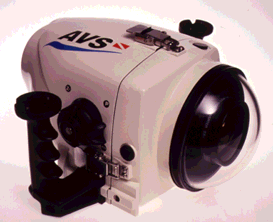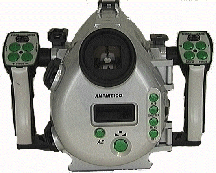 Home : Video course : Module 2: Video Housings : Video Housings Home : Video course : Module 2: Video Housings : Video Housings
Regardless of the materials from which they are made
housings fall into two basic categories; camcorder specific and universal.
Camcorder specific housings only take one model whilst universal housings take
many.
Camcorder specific housings usually only take the one
camcorder because they rely on mechanical transmission of control functions (via
levers and shafts drilled through the housing). Other models are precluded
because their controls are in physically different places. The 'upgrade-ability'
factor is an important feature to look for in a housing and mechanical housings
do not score well on this point, although some can be adapted (at expense by the
manufacturer) for other models of camcorder.
In their favor mechanical control housings are usually
cheaper and sometimes the only option for obscure makes of camcorder. However,
mechanical transmission of functions not only increases the potential for leaks,
has moving parts that wear out (and therefore need to be serviced), but also you
are physically limited as to how many functions you can access.

Universal housings usually have electronic controls. This system
requires no holes in the housing as external controls transmit signals by
electromagnetism through the body of the housing. The control buttons have
magnets inside which come into proximity with a switch (called a reed relay) inside the housing when pressed. The switch then 'makes'
and operates the appropriate control via electronic connection to the camcorder.
Such systems need electronics inside in order to interface with the camcorder
(and a flying lead with a mini jackplug, which plugs into the LANC - remote
control - socket). This system has been around some time with video housings and
is proven technology.
Electronic housings can usually take several models,
which means that you have more choice and greater likelihood of getting the
camcorder features that you want underwater.
To install the camcorder in the electronic housing you
usually attach the camcorder to a universal tray via the tripod bush and then
slot the tray into a guide rail. With electronic housings you just plug in the
jackplug and you are ready to go! There are no fiddley connections that could be
easily damaged.
A universal housing is an excellent investment because it is upgradeable to new models. You probably
won't have to throw away this housing when you upgrade
to a new camcorder. There can be no guarantees with universal (electronic) housings of
course but, provided future models don't get bigger (unlikely) and as long
as they have a remote plug (all modern camcorders have one for interface with editing equipment)
then there is a good chance later models will
fit. A good example is the Top Dawg housing.

Whether mechanical or electronic, controls should be
positive and fall to hand. Strictly speaking, the only vital control functions
to look for on a housing are Record and Stop. In most situations you can rely on
the technology to focus automatically. However, you will want to zoom in and out
to crop your shots for interest. Most housings have these controls as a minimum.
Ideally you should be able to focus manually. This is particularly useful in low
vis as autofocus systems may start hunting (searching) if there is a lot of
particles in the water and so you will want to over-ride it.
Some top of the range housings allow you access to other
functions. White balance control is useful to adjust for different lighting
conditions, although most camcorders do this automatically anyway. Exposure
control can be useful in contrasty conditions.
The housing should be contoured to fit like a glove,
which means that it is more neutrally buoyant underwater than other designs. If
it is not neutrally buoyant, the housing should be slightly positive.
 Housings
with wasted space in them should be avoided because the airspace will make them
far too positively buoyant and therefore need ballast, which is not what you
want to carry in your bags on your foreign diving holiday! Housings
with wasted space in them should be avoided because the airspace will make them
far too positively buoyant and therefore need ballast, which is not what you
want to carry in your bags on your foreign diving holiday!
Next >> Choosing a Housing
|